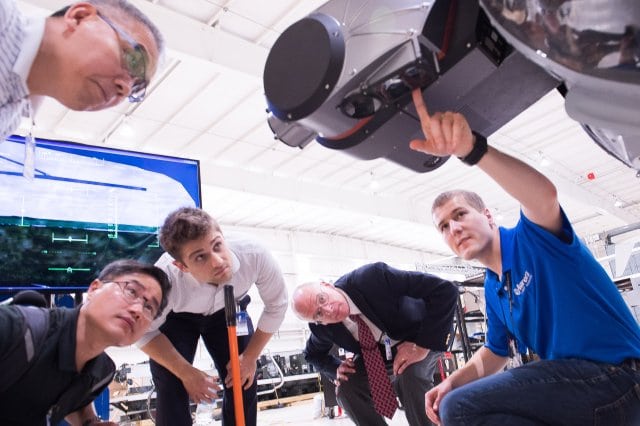
Aerospace engineers from the U.S. Army Research Laboratory at Aberdeen Proving Ground, Maryland, tour Aurora Flight Sciences at company headquarters in Manassas, Virginia. Photo by David McNally
The U.S. Army Research Laboratory is interested in unmanned aircraft systems from Aurora Flight Sciences. The Virginia-based engineering firm hosted a visit from some Army aerospace engineers earlier this month, the Army said. Aurora had previously visited Army research facilities at Aberdeen Proving Ground, Maryland.
“The Army hopes to achieve high-speed, high-endurance and high-payload capabilities for vertical-lift platforms,” the service said. “To achieve those goals, the researchers said they are interested in building a collaborative relationship with Aurora.”
Earlier this month, the U.S. Air Force awarded a $499 million contract to Aurora to support its Aerospace Systems Air Platform Technology Research program. Research in this program supports potential development, demonstration, integration and transition of new affordable and “revolutionary” aircraft technologies and systems to warfighters, according to the program’s statement of objectives from March 2016.
Aurora is also working under contract with the U.S. Defense Advanced Research Projects Agency. In April, the two entities said its XV-24A LightningStrike subscale vehicle demonstrator completed its planned flight-test program. The full-scale demonstrator is currently in production, with its flight-test program slated for late 2018.
While visiting Aurora, the Army saw a project on which the firm was working for the U.S. Navy and Marine Corps. Aurora is developing an autonomous flight system that the services could retrofit to existing aircraft. The Army said that according to Aurora officials, the system would give a Marine on the ground “the ability to request a supply delivery via helicopter, which flies to their location with minimal human assistance and autonomously land in an austere, possibly hostile landing zone.”
According to Rajneesh Singh, an acting division chief in the laboratory’s Vehicle Technology Directorate, the laboratory hopes to move forward with a partnership with Aurora. The next step would be to explore a cooperative research and development agreement, or CRADA, he said. Aurora has already provided the Army with white papers for its review.
“We’ll identify individual areas for each party to contribute and then develop a CRADA mechanism to identify individual responsibilities,” Singh said. “We’ll work together to create a plan to continue advancing the work that has been done with the significant [Defense Department] investment.”
The Army Laboratory runs on an open-campus business model. Researchers are encouraged to collaborate with both industry and academia.